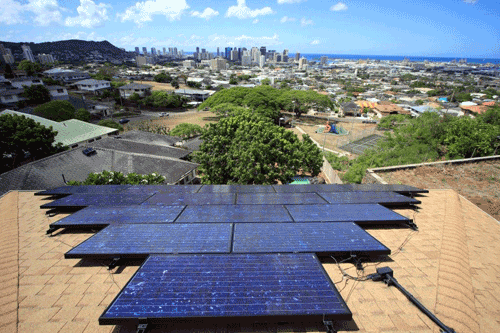
Wärtsilä supplies 50 MW power plant to help integration of solar energy in Hawaii
Wärtsilä will supply a 50 MW Smart Power Generation power plant to Hawaiian Electric Company on the island of Oahu. The plant will help enable the integration of more solar photovoltaic (PV) generation on the island. The project requires approval by the Hawaii Public Utilities Commission. If approved, the power plant is scheduled to be operational in 2017.
“We need to transform our generation portfolio to be more flexible and quick-starting in order to integrate more renewable energy, especially solar power. This project is an important step in that direction,” said Jack Shriver, Hawaiian Electric senior engineer. “Internal combustion engines (ICE) provide a solution to our requirements, since they are fast-reacting, efficient and capable of running on multiple fuels,” he added.
The power station will run on a biofuel blend, which will include liquid fuels and natural gas when liquefied natural gas (LNG) becomes available on the island, and it is part of the plan to reduce the island’s reliance on oil and coal-based generation. The plant will consist of six Wärtsilä 34DF engines with combined output of 50 MW. The power plant will be located on Schofield Barracks Army base, about 40 kilometres from Honolulu.
Solar PV capacity is growing exponentially in Hawaii. According to the Interstate Renewable Energy Council, Hawaii has the highest per capita installed capacity of PV systems in the United States, 255 watts per person. The US average is 37.9 watts per person. About 12 percent of all single-family residential dwellings have solar panels in Hawaii.
The official goal for Hawaii is to grow the share of renewable electricity from 15 percent in 2015 to 25 percent in 2020, and 40 percent in 2030. However, Hawaiian Electric is already over 18 percent, exceeding the 2015 goal, and the company recently filed a plan that would exceed 65 percent by 2030. “In order to succeed in this we need fast-reacting capacity. ICEs are a key aspect to that. We can start them up multiple times daily, reach full load in less than 10 minutes, and shut them off whenever we don’t need them. As the amount of solar power on the island continues to increase, we will reach the point where during sunny days, we will need to ramp down our existing steam units more than they were designed to do,” Shriver said.
“Solar energy comes and goes. You need something fast to fill the gaps,” Wärtsilä’s Regional Director Wayne Elmore said. “We are thrilled to see, once again, that our Smart Power Generation technology is a perfect companion to variable renewable energy. Fast back-up capacity not only supports but enables much more wind and solar. This is key to sustainable power systems.”
Wärtsilä has a long track record of balancing the output of wind farms with power plants in the Continental US. The latest project is a 225 MW wind-integrating power station under construction in Oregon, scheduled to go online in early 2015. Wärtsilä’s total installed power generation capacity in the United States is some 2400 MW. In Hawaii, Wärtsilä has previously supplied two power plants to the islands of Kauai and Maui with a combined capacity of 38 MW.
According to a recent report by the International Energy Agency (IEA), ICEs are a promising technology for supporting wind and solar energy. Comparing different flexibility resources for power systems, the IEA report says that gas-fired ICE power plants are a ”very mature technology” and ”cost-competitive to OCGTs” (Open Cycle Gas Turbines). The IEA notes that “growth in ICE plants actually exceeds that of turbine-based technologies”. According to the IEA, the key asset of engine-based generation is its fast starting and ramping capability. Quick reaction time is essential in order to follow the output of wind and solar as closely as possible. The findings were published in the IEA’s Energy Technology Perspectives 2014.
Link to photo: Solar PV in Hawaii
Caption: There are more than 40,000 rooftop solar installations in Hawaii, most of them on the main island of Oahu. Their fluctuating generation presents a challenge for grid operators.
Link to chart: solar PV capacity in Hawaii 2007–2013
Caption: Solar PV capacity in Hawaii has grown 80-fold in seven years. Without proper back-up capacity, the intermittent generation is difficult to absorb in the grid.
Source: Interstate Renewable Energy Council: US Solar Market Trends 2007–2013.
For further information please contact:
Wayne Elmore
Business Development
Wärtsilä North America, Inc.
Tel: +1 281 233 6213
wayne.elmore@wartsila.com
Juka-Pekka Niemi
General Manager, Marketing
Wärtsilä Energy Solutions
Tel: +358 10 709 0000
jukka-pekka.niemi@wartsila.com
Wärtsilä Power Plants in brief
Wärtsilä Power Plants is a leading global supplier of flexible baseload power plants of up to 600 MW operating on various gaseous and liquid fuels. Our portfolio includes unique solutions for peaking, reserve and load-following power generation, as well as for balancing intermittent power production. Wärtsilä Power Plants also provides LNG terminals and distribution systems. As of 2014, Wärtsilä has 56 GW of installed power plant capacity in 170 countries around the world.
www.smartpowergeneration.com
Wärtsilä in brief
Wärtsilä is a global leader in complete lifecycle power solutions for the marine and energy markets. By emphasising technological innovation and total efficiency, Wärtsilä maximizes the environmental and economic performance of the vessels and power plants of its customers. In 2013, Wärtsilä's net sales totalled EUR 4.7 billion with approximately 18,700 employees. The company has operations in more than 200 locations in nearly 70 countries around the world. Wärtsilä is listed on the NASDAQ OMX Helsinki, Finland.
www.wartsila.com

